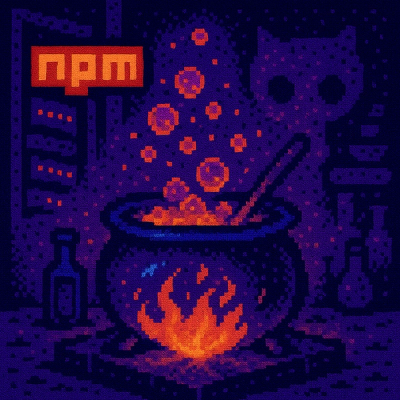
Research
/Security News
9 Malicious NuGet Packages Deliver Time-Delayed Destructive Payloads
Socket researchers discovered nine malicious NuGet packages that use time-delayed payloads to crash applications and corrupt industrial control systems.
vue-css-donut-chart
Advanced tools
| Using Vue 2? |
|---|
| Check out the documentation for vue-css-donut-chart v1. |
| NPM - https://www.npmjs.com/package/vue-css-donut-chart/v/legacy |
Live demo – https://dumptyd.github.io/vue-css-donut-chart/
Playground – https://jsfiddle.net/dumptyd/f4tmz0oy/
yarn add vue-css-donut-chart
# OR
npm i vue-css-donut-chart
# OR
pnpm add vue-css-donut-chart
<!-- unpkg -->
<link rel="stylesheet" href="https://unpkg.com/vue-css-donut-chart@2/dist/vcdonut.css">
<script src="https://unpkg.com/vue-css-donut-chart@2"></script>
<!-- OR -->
<!-- jsDelivr -->
<link rel="stylesheet" href="https://cdn.jsdelivr.net/npm/vue-css-donut-chart@2/dist/vcdonut.css">
<script src="https://cdn.jsdelivr.net/npm/vue-css-donut-chart@2/dist/vcdonut.umd.min.js"></script>
<!-- registration -->
<script>
const app = Vue.createApp({});
app.use(vcdonut.default); // component will be available as 'vc-donut'
</script>
<template>
<vc-donut :sections="sections">Basic donut</vc-donut>
</template>
<script setup>
import { VcDonut } from 'vue-css-donut-chart';
const sections = [{ value: 25 }, { value: 25 }];
</script>
<template>
<vc-donut
background="white"
foreground="grey"
:size="200"
unit="px"
:thickness="30"
has-legend
legend-placement="top"
:sections="sections"
:total="100"
:start-angle="0"
auto-adjust-text-size
:suppress-validation-warnings="false"
@section-click="handleSectionClick"
@section-mouseenter="handleSectionEvent"
@section-mouseleave="handleSectionEvent"
@section-mouseover="handleSectionEvent"
@section-mouseout="handleSectionEvent"
@section-mousemove="handleSectionEvent">
<h1>75%</h1>
</vc-donut>
</template>
<script setup>
import { VcDonut } from 'vue-css-donut-chart';
const sections = [
{ label: 'Red section', value: 25, color: 'red' },
{ label: 'Green section', value: 25, color: 'green' },
{ label: 'Blue section', value: 25, color: 'blue' }
];
const handleSectionEvent = (section, event) => {
console.log(`Section: ${section.label} | Event: ${event.type}.`);
};
</script>
Set thickness to 0 to make the component look like a pie chart.
<template>
<vc-donut
:sections="[{ value: 35 }, { value: 15 }, { value: 15 }, { value: 35 }]"
:thickness="100">
</vc-donut>
</template>
<script setup>
import { VcDonut } from 'vue-css-donut-chart';
</script>
Note: setting thickness to 100 will completely hide the chart's text or slot content. The content will still be present in the DOM, but it will not be visible.
| Prop | Type | Required | Default | Description |
|---|---|---|---|---|
size | Number | No | 250 | Diameter of the donut. Can be any positive value. |
unit | String | No | 'px' | Unit to use for size. Can be any valid CSS unit. Use % to make the donut responsive. |
thickness | Number | No | 20 | Percent thickness of the donut ring relative to size. Can be any positive value between 0-100 (inclusive). |
text | String | No | – | Text to show in the middle of the donut. This can also be provided through the default slot. |
background | String | No | '#ffffff' | Background color of the donut. In most cases, this should be the background color of the parent element. |
foreground | String | No | '#eeeeee' | Foreground color of the donut. This is the color that is shown for empty region of the donut ring. |
start-angle | Number | No | 0 | Angle measure in degrees where the first section should start. |
total | Number | No | 100 | Total for calculating the percentage for each section. |
has-legend | Boolean | No | false | Whether the donut should have a legend. |
legend-placement | String | No | 'bottom' | Where the legend should be placed. Valid values are top, right, bottom and left. Doesn't have an effect if has-legend is not true. |
auto-adjust-text-size | Boolean | No | true | Whether the font-size of the donut content is calculated automatically to fit the available space proportionally. |
sections | Array | No | [] | An array of objects. Each object in the array represents a section. |
section.value | Number | Yes | – | Value of the section. The component determines what percent of the donut should be taken by a section based on this value and the total prop. Sum of all the sections' value should not exceed total. |
section.color | String | Read description | Read description | Color of the section. The component comes with 24 predefined colors, so this property is optional if you have <= 24 sections without the color property. |
section.label | String | No | 'Section <section number>' | Name of the section. This is used in the legend as well as the tooltip text of the section. |
section.ident | String | No | – | Identifier for the section. This can be used to uniquely identify a section in the section-* events. |
suppress-validation-warnings | Boolean | No | false | Whether to suppress warnings for invalid prop values. |
All the section-* listeners are called with the section object on which the event occurred and the native Event object as arguments respectively.
Use the ident property to uniquely identify sections in the section-* events.
| Event | Parameter | Description |
|---|---|---|
section-click | section, event | Emitted when a section is clicked. |
section-mouseenter | section, event | Emitted when the mouseenter event occurs on a section. |
section-mouseleave | section, event | Emitted when the mouseleave event occurs on a section. |
section-mouseover | section, event | Emitted when the mouseover event occurs on a section. |
section-mouseout | section, event | Emitted when the mouseout event occurs on a section. |
section-mousemove | section, event | Emitted when the mousemove event occurs on a section. |
| Slot | Description |
|---|---|
| default slot | If you want more control over the content of the chart, default slot can be used instead of the text prop. |
legend | Slot for plugging in your own legend. |
This package is written in TypeScript and comes with its own type definitions out of the box. The types are exported from the main package, so you can import them directly in your project.
<script setup lang="ts">
import { ref } from 'vue';
import { VcDonut } from 'vue-css-donut-chart';
import type { DonutSection, DonutChartProps, DonutChartEmits } from 'vue-css-donut-chart';
const sections = ref<DonutSection[]>([
{ label: 'Red section', value: 25, color: 'red' },
{ label: 'Green section', value: 25, color: 'green' },
{ label: 'Blue section', value: 25, color: 'blue' }
]);
const otherProps: DonutChartProps = {
size: 200,
unit: 'px',
thickness: 30,
hasLegend: true,
// ...
};
</script>
Issues – https://github.com/dumptyd/vue-css-donut-chart/issues
Code released under MIT license.
2.1.0
suppress-validation-warnings to suppress warnings about invalid values.size.auto-adjust-text-size now uses ResizeObserver instead of window resize event. This will allow for more accurate text size adjustments when the component is resized dynamically.FAQs
Lightweight Vue component for creating donut charts
The npm package vue-css-donut-chart receives a total of 3,771 weekly downloads. As such, vue-css-donut-chart popularity was classified as popular.
We found that vue-css-donut-chart demonstrated a not healthy version release cadence and project activity because the last version was released a year ago. It has 1 open source maintainer collaborating on the project.
Did you know?

Socket for GitHub automatically highlights issues in each pull request and monitors the health of all your open source dependencies. Discover the contents of your packages and block harmful activity before you install or update your dependencies.

Research
/Security News
Socket researchers discovered nine malicious NuGet packages that use time-delayed payloads to crash applications and corrupt industrial control systems.

Security News
Socket CTO Ahmad Nassri discusses why supply chain attacks now target developer machines and what AI means for the future of enterprise security.

Security News
Learn the essential steps every developer should take to stay secure on npm and reduce exposure to supply chain attacks.